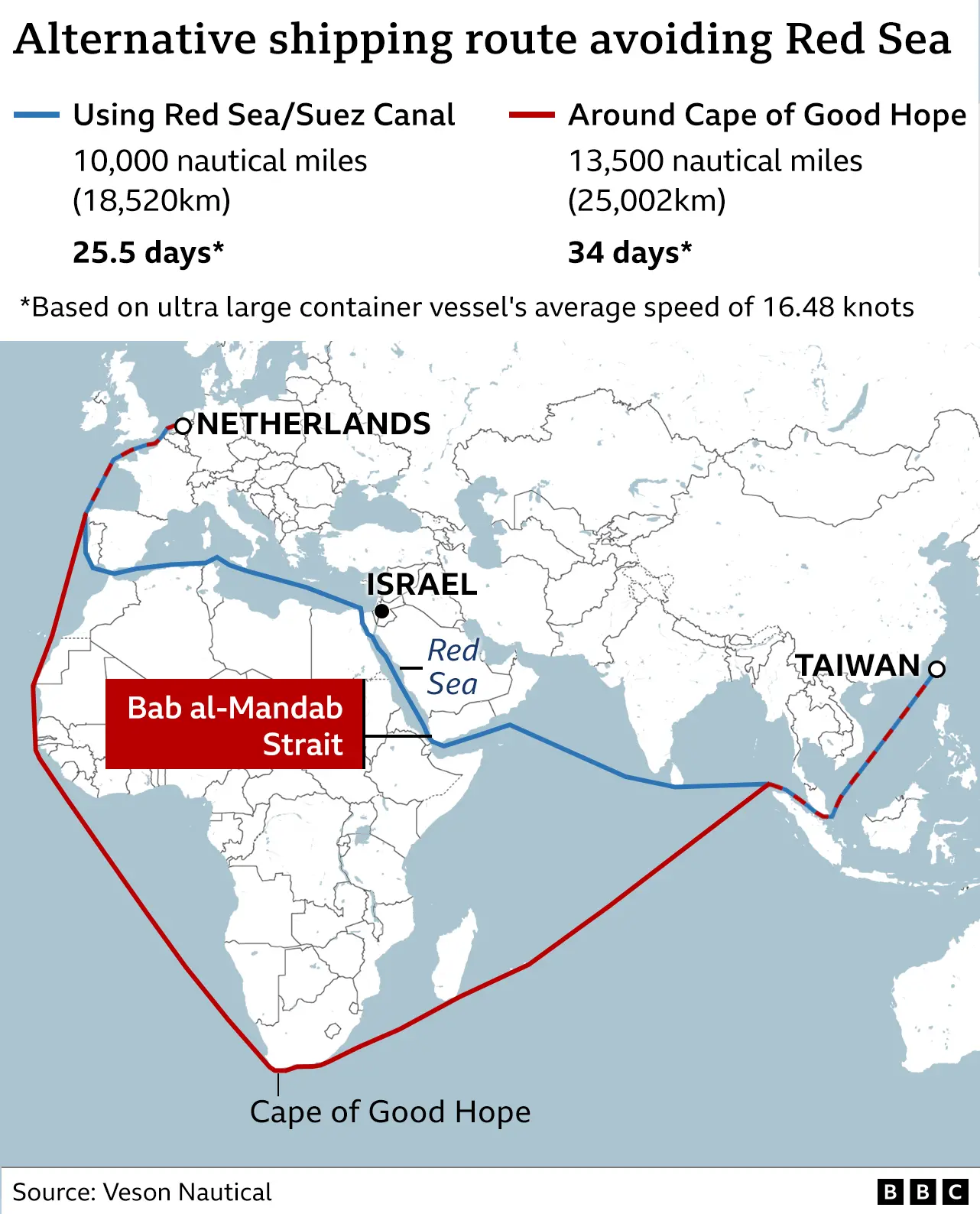Navigating Geopolitical Turbulence: Learnings from the Red Sea Crisis
Welcome to this weeks Whale Logistics blog post. This week, we delve into the latest geopolitical developments and their potential impact on global supply chains. From the ongoing crisis in the Red Sea to emerging flashpoints like the South China Sea and the Strait of Malacca, we explore how these disruptions could affect Australian businesses and shipping in 2025.
Since the hijacking of the British tanker Galaxy Leader in November 2023, the Houthis have launched over 130 attacks in the Red Sea, according to the Armed Conflict Location and Event Data (ACLED). Since then, global shipping has been disrupted through the rerouting of vessels around the Cape of Good Hope to avoid the attacks, delaying supply chains and increasing global shipping costs.
Despite widespread agreement on the need for international cooperation to minimise disruptions to global trade, the Houthis' persistence has hindered significant progress. The duration of these disruptions and the timeline for a return to normality remain uncertain.
This latest global supply chain crisis underscores the risks shippers face as they navigate global trade routes.

What’s Being Done
A range of international and regional stakeholders, including the UN Security Council, which passed a ceasefire resolution in January, and organisations like the International Maritime Organisation (IMO) and the World Shipping Council, have condemned the attacks and called for enhanced maritime security operations. However, there are limited operational mechanisms for multilateral cooperation in the region to create a safe passage for vessels.
Operation Prosperity Guardian, a U.S.-led international coalition force of over 20 nations, was launched in December 2023 to secure the Bab al-Mandab corridor. While the coalition has thwarted numerous attacks, the Houthis remain undeterred.
The Next Red Sea: Potential Geopolitical Flashpoints
The Red Sea crisis highlights the impact of geopolitical conflicts on global trade. This poses the question of where the next major geopolitical flashpoint is to occur. Other strategically important waterways where similar disruptions could occur include:
The South China Sea: Nearly 60% of global trade passes through this region, which is fraught with territorial disputes involving China, the Philippines, Taiwan, Vietnam, Brunei, and Malaysia. Rising tensions, particularly between China and the Philippines, could significantly impact global trade if tensions continue to rise. This may affect the SEA markets and shipping within this region – negatively affecting Australian importers.
The Strait of Malacca: Connecting the South China Sea with the Indian Ocean, this strait is crucial for trade between Asia, the Middle East, and Europe. It facilitates the import of nearly 80% of China’s oil. Furthermore, the Strait of Malacca provides shippers access to the transshipment port of Singapore. Geopolitical and environmental disruption here could see large delays and reduce access to the SEA markets. Alternative routes like the Sunda Strait are available but less efficient, driving up transit times and the cost of shipping if these disruptions occur.
The Strait of Hormuz: A vital chokepoint for global oil trade, with around 90 ships passing daily. Prolonged closure could trigger an energy crisis, increasing shipping costs. Gulf nations reliant on oil revenues have a vested interest in maintaining safe passage, but the region's history of conflict poses a significant risk to Australian shippers.

Lessons in Supply Chain Risk Management
Operating a global supply chain means geopolitical risks are unavoidable, but their impact can be managed. Whale Logistics Australia suggests the following to reduce the potential impacts on Australian importers.
Control the Controllable: Importers can protect themselves from disruption by diversifying supplier networks to reduce reliance on vulnerable trade routes and countries of origin. Nearshoring is a common practice to mitigate such risks, and the Red Sea crisis may accelerate the shift away from globalisation to a more regionalised supply chain strategy.
Moreover, safety stock levels can also be increased to protect against disrupted supply chain networks, although the cost associated with carrying excess inventory must be balanced against the risk of disruption.
Invest in Supply Chain Visibility: Real-time visibility provides situational awareness and helps manage risk exposure for importers. It allows supply chain stakeholders to focus on response plans, minimising disruptions and maintaining stability. Whale Logistics offers various IT solutions to enhance its logistics services and provide transparency of operation to its clients. These include Expedient ERP, SQL Database, HubSpot, and Phocas. These tools streamline shipment processing, offer real-time visibility, support client communications, and provide advanced reporting capabilities – helping minimise disruption.
Make Contingency Planning a Priority: When de-risking isn't possible, contingency planning is essential in ensuring supply chain robustness. Working with your suppliers to understand the options available if a crisis occurs, is an effective strategy to preparing for supply chain disruptions. Whale Logistics leverages its vast agent network, trade routes and transport modes to assist its customers. Our weekly market EDM keeps clients informed about market trends and impending disruptions, enabling proactive decision-making. By utilising our extensive network and real-time market insights, we ensure that our clients are well-prepared to handle any crisis.
By staying informed and proactive, businesses can better navigate the complexities of geopolitical risks and maintain resilient supply chains.
For more information on Whale Logistics services, click here or contact one of our Key Account Management team to learn more.
Related Posts
You might also like
-
Apr 17 2025
Amid rising China and the US trade disputes, businesses worldwide are reassessing their supply chains. Vietnam has ...
-
Apr 08 2025
Welcome to the Whale Charge Code Glossary! To learn about what each charge represents on your rate card and its ...
-
Mar 12 2025
Welcome to Riding the Wave - Whale Logistics Monthly Market Update


